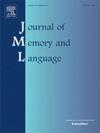Visual word recognition is impeded by adjacent words
IF 3
1区 心理学
Q1 LINGUISTICS
引用次数: 0
Abstract
We report two experiments demonstrating that visual word recognition is impeded by the presence of nearby stimuli, especially adjacent words. Reading research has converged on a consensus that skilled readers control their attention to make use of information from adjacent (primarily upcoming) words, increasing reading efficiency. Other lines of research seem to point to potential interference from nearby items, yet this has not been investigated at the critical lexical level. To specifically target lexical activation, here we employ a novel variant of the visual world paradigm with masked (75 ms) flanked visual word targets, contrasting five flanker conditions across two experiments, namely none, repeated symbols, unknown font strings, pseudowords, and words. Analysis of multiple observed variables from 60 and 58 adult Norwegian speakers showed strong interference—compared to no flankers—for all flanker conditions except the repeated symbols. Interference increased with additional levels of possible flanker processing, and was greatest for higher-frequency word targets, consistent with rapid dynamic modulation of attentional breadth. Our findings demonstrate that nearby words interfere with lexical activation of the fixated word and call for a more nuanced approach to the role of preview in fluent reading. We conclude that skilled reading involves a constant complex interplay between the drive toward efficiency, which requires a broad attentional field, and the need to shield processing from interference, which limits attentional breadth.
视觉单词识别受到相邻单词的阻碍
我们报告了两个实验,证明视觉单词识别受到附近刺激的阻碍,特别是相邻单词。阅读研究已经达成共识,熟练的读者控制他们的注意力,利用邻近(主要是即将到来的)单词的信息,提高阅读效率。其他研究似乎指出了来自附近物品的潜在干扰,但这还没有在关键词汇水平上进行调查。为了专门针对词汇激活,本研究采用了一种新的视觉世界范式,在两个实验中,我们用蒙面(75毫秒)侧翼视觉单词目标,对比了五种侧翼条件,即无、重复符号、未知字体字符串、假词和单词。对60名和58名成年挪威语使用者的多个观察变量的分析表明,除了重复的符号外,与没有侧标相比,所有侧标条件下的干扰都很强。干扰随着可能的侧面加工水平的增加而增加,并且对高频单词目标的干扰最大,这与注意广度的快速动态调制一致。我们的研究结果表明,附近的单词会干扰固定单词的词汇激活,因此需要更细致的方法来研究预览在流畅阅读中的作用。我们得出的结论是,熟练的阅读涉及到追求效率(需要广泛的注意力领域)和保护处理不受干扰(限制了注意力广度)之间不断复杂的相互作用。
本文章由计算机程序翻译,如有差异,请以英文原文为准。
求助全文
约1分钟内获得全文
求助全文
来源期刊
CiteScore
8.70
自引率
14.00%
发文量
49
审稿时长
12.7 weeks
期刊介绍:
Articles in the Journal of Memory and Language contribute to the formulation of scientific issues and theories in the areas of memory, language comprehension and production, and cognitive processes. Special emphasis is given to research articles that provide new theoretical insights based on a carefully laid empirical foundation. The journal generally favors articles that provide multiple experiments. In addition, significant theoretical papers without new experimental findings may be published.
The Journal of Memory and Language is a valuable tool for cognitive scientists, including psychologists, linguists, and others interested in memory and learning, language, reading, and speech.
Research Areas include:
• Topics that illuminate aspects of memory or language processing
• Linguistics
• Neuropsychology.

 求助内容:
求助内容: 应助结果提醒方式:
应助结果提醒方式:


